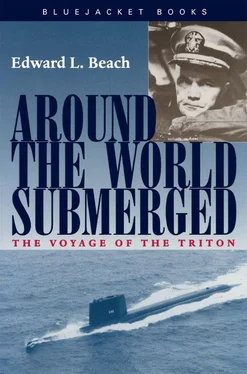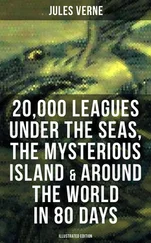Walsh’s hands flew to the controls for the hydraulic plants, started the stand-by pump, then waited, with his right hand hovering near the switch to the air inlet valve. It was a similar valve which somehow failed to close in 1939, when USS Squalus sank near the Isle of Shoals off Maine, losing nearly half her crew. In Squalus, this valve had been much larger than our own, for it supplied air to four great diesel engines in the engine room, whereas in our case it only provided ventilation below decks. But it was still important that it be closed when we dived.
The horn stopped; then came a second blast. I stepped clear of the hatch, and moments later a pair of legs clattered down the ladder, followed closely by another pair. Tom Schwartz, Torpedoman’s Mate Third—known variously as “the nose,” “the face,” or “the profile”—scrambled off the ladder and threw himself into one of the seats at the diving stand. William A. McKamey, Seaman, practically on Schwartz’s heels, settled himself at the other seat.
Jim Hay, as Officer of the Deck, would be the last man off the bridge. His next duty was to see that the watertight hatch leading to the bridge was properly shut. He would be up there right now checking it.
With the second blast of the alarm, Walsh snapped the switch to shut Triton’ s main air valve. Then, playing upon the Ballast Control Panel as though it were an organ console, while intently eying the board of indicator lights glowing before him, he swept his hand swiftly and precisely across the face of the panel to open the twenty-two main ballast tank vents with which Triton was fitted. That done, he remained poised, one hand on the master switch which would shut at least half of the ballast tank vents, the other on the main air blow valve control. The bridge hatch still indicated open on his panel—as it should until completely closed. This is one of the crucial operations in diving; no skipper can completely divest himself of the urgent need to know that the bridge hatch has been properly shut. As soon as McKamey had passed me. I stepped back to the ladder and looked up into the conning tower. The ordered bustle there reassured me, as it always did, and as I looked up, Beacham’s voice sang out to Hay, “Hatch secured, sir!”
I cast my eyes quickly back to Walsh. He had relaxed ever so slightly. The red circle, indicating that the conning tower hatch was open, had been replaced by a single short bar.
McKamey and Schwartz, each pulling the steel pin which had locked their control columns in the neutral position, pushed the bow and stern planes forward, positioning them to a dive angle. Approximately fifteen seconds had passed since the end of the second blast of the diving alarm, and Triton’ s surface motion had already changed. Our wide open main ballast tanks had taken aboard nearly all of the two thousand tons of water they could hold—and our six-thousand-ton Triton, cruising powerfully on the surface of the sea, had become an eight-thousand-ton submarine. Her bow began to incline; Jim Hay slipped around me and took his station behind the two planesmen. The depth gauges were showing that our keel was forty feet below the surface and going deeper.
“Depth, Captain?” asked Jim, his eyes on the depth gauges.
“One hundred and fifty feet, Jim,” I told him. “Keep the fathometer going and don’t get any closer than seventy-five feet from the bottom.”
This area had been well swept by many years of submarine operations south of Montauk Point. All wrecked ships or rock outcroppings, which might present a hazard to a submarine operating close to the bottom, had been discovered and plotted. Nevertheless, and particularly at the speed we were going, it was desirable to be more than careful.
A thirty-five-fathom sounding from Triton’ s fathometers indicated an actual depth of water, counting our own draft, of nearer to forty fathoms, or two hundred and forty feet. A keel depth of one hundred and fifty feet, therefore, should leave us ninety feet of water between our keel and the bottom of the sea. At this depth our periscopes could not extend to the surface, but our speed would have rendered them useless anyway. On the other hand, even if the biggest ship in the world were to pass directly overhead—though we’d probably be startled at the noise she’d be making—there would be no danger of collision. The only thing we needed to worry about at all was the possibility of encountering another submerged submarine, and this had been taken care of administratively, so far as our own subs were concerned, by assigning Triton a sea lane from which all other submarines had been excluded. There was, of course, a chance that a submarine belonging to another country might have chosen this precise moment to be submerged in this very area. But it was a remote possibility, barely worth consideration.
“Jim,” I said, “the bottom drops away very gradually on the continental shelf until it reaches the hundred-fathom curve. From there on out, it drops much more rapidly into the deep ocean. Stay at this depth until the fathometer indicates a hundred and fifty feet of water under us; then follow the bottom on down until you get to our running depth.”
“Aye, aye, Captain!” said Jim, and looked up at me expectantly. I knew what was in his mind. He was thinking, “Are you going to announce where we’re going, now that we’ve dived?”
I shook my head slightly, hoping he could read the answer.
Taking a gentle inclination by the bow, Triton effortlessly descended to her assigned depth. With our tremendous speed and the shallow water, an easy angle was indicated. With practiced ease, though I knew they were watching their controls carefully, Schwartz and McKamey drove her down and leveled her off, coached occasionally by a few words from Jim. Directly behind Hay, Walsh had a number of additional duties on the Ballast Control Panel, which he carried out automatically and without command, occasionally checking with Jim or vice versa.
Carter, in the meantime, and Bruce Gaudet, the IC Electrician stationed on his far side, had a number of operations to carry out, consisting mainly of securing topside electrical connections, speaker talk-back circuits, and the like. Thamm, apparently satisfied, quietly departed.
It was considerably warmer in the control room than on the bridge, and I felt it. Jim was struggling out of his bridge gear, while he kept close attention on the diving station in front of him, and in a few minutes, when the bustle of diving had pretty well died away, Seaman Jim Smith, evidently the off lookout—he must have been hiding somewhere for I had failed to see him earlier—came forward in a light dungaree shirt and trousers and offered to relieve McKamey.
With the ship steady at one hundred fifty feet, the depth gauges no longer moving, Jim gave the permission. Smith squatted alongside McKamey, and in a low voice McKamey passed over the instructions he had received.
“OK,” said Smith in a moment, grasping the control stick. “I’ve got it.” In a long-practiced motion, with his left hand he swept up the right arm of the seat in which McKamey was seated—it had been built with a hinge at the back for precisely this purpose—and at the same moment, McKamey, releasing the control column to Smith, flipped up the arm on the far side of the seat, shifted his feet, rose, and stepped back. Effortlessly, Smith slid into his place, and as McKamey passed behind him, he pushed back both arm rests. Triton was already settled into her normal submerged routine.
I nodded to Hay. “You have the deck and the Conn, Jim,” I said. “I’m going aft now. Keep the fathometer going and maintain a careful sonar watch. Call me if you hear anything.”
Читать дальше












